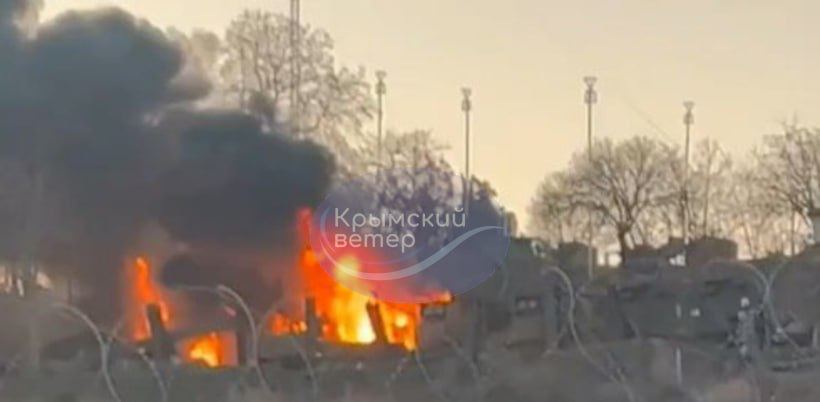Empty resorts, animal deaths, and explosions: How Crimea has changed since Russia's occupation
 What Crimea was like before Russia's annexation (collage: RBC-Ukraine)
What Crimea was like before Russia's annexation (collage: RBC-Ukraine)
Before the occupation in 2014, Crimea had crowded beaches, sunny coasts, the smell of the sea, and baklava in the air. On February 20, 2014, the fate of the peninsula changed. Today, the resort towns look completely different.
Sources used: Krymskyi Veter Telegram channel, Wikipedia, Radio Liberty, photos and videos from open sources.
How the occupation took place
The seizure of the Crimean peninsula by the Russian army began on February 20, 2014. After Viktor Yanukovych fled from power, anti-Ukrainian protests began in Crimea.
On February 23, a 20,000-strong rally was held in Sevastopol, where a decision was made not to transfer taxes to Kyiv, and Russian citizen Alexei Chaly was proclaimed mayor.
Soon, checkpoints and Russian armored personnel carriers appeared at the entrances to Sevastopol.
On February 25, visitors and local separatists held rallies in front of the Crimean parliament. Pro-Ukrainian forces also gathered a large rally, which postponed a meeting of the Crimean parliament, which was scheduled to consider the political future of the Autonomous Republic of Crimea.
In response, on the night of February 27, the Crimean parliament and government were seized by unmarked Russian special forces, and Russian flags were hung. The Russian occupiers herded some of the deputies into the seized parliament building and forced them to adopt a decision to call a referendum on the status of Crimea.
On the same day, the ferry crossing in Kerch and the Belbek airport in Sevastopol were shut down. But today the airport looks a little different.

A hit to the Belbek airport in Sevastopol (photo: Krymskyi Viter Telegram channel)

A hit to the Belbek airport in Sevastopol (photo: Krymskyi Viter Telegram channel)
Almost simultaneously, the so-called little green men (Russian military - ed.) began blocking Ukrainian military units, ships, and facilities on the peninsula.
The results of the referendum were falsified. It allegedly collected more than a million completed ballots, 96% of which allegedly indicated a choice "for the reunification of Crimea with Russia as a subject of the Russian Federation."
Natural resources
Anyone lucky enough to visit Crimea can attest to the incredible nature there. Out of all Ukrainian Red Data Book species, about 40% of plant species and 60% of animals grow and live on the peninsula.
Moreover, 44 species of plants and 19 species of animals exist only in Crimea and nowhere else in the world.
However, the activities of the Russian occupiers led to the decline of the natural heritage, says ecologist Natalia Kozbur.
The construction of the Kerch Bridge has perhaps the most negative impact.
"Russia even passed special legislation to avoid environmental impact assessment. The bridge causes pollution of the sea because of the transport that moves across it. The flora and fauna of the Sea of Azov are very sensitive to the slightest changes in the environment and are under threat of extinction. These include two Red Book dolphin species, several species of fish, crabs, and birds that migrate through the Kerch Strait," says Natalia.
 The unique Crimean flora (photo: open sources)
The unique Crimean flora (photo: open sources)
 The unique Crimean flora (photo: open sources)
The unique Crimean flora (photo: open sources)
Another problem for the flora and fauna of the peninsula is the uncharacteristic militarization. The Russian occupiers set up military bases and warehouses and conducted exercises in protected areas.
"The use of ammunition leads to chemical contamination of soil and air. The territories of the landfills have been turned into areas completely unsuitable for economic activity. Most ammunition is tested in the sea, which leads to the destruction of flora and fauna, as well as chemical pollution of the sea," the expert emphasizes.
After the weapons testing, the reserve lands became unsuitable for growing plants or breeding animals.
Currently, it is impossible to establish the exact area of all the test sites. However, it is known that only the Opuk and Chauda test sites have a total area of more than 55,000 hectares.
Water problems
The Russian dictatorship interprets the occupation of the peninsula as "bringing Crimea home". But it was not a very welcome guest, because almost immediately a humanitarian catastrophe began in cities and villages.
The main source of water supply at the beginning of the occupation was the North Crimean Canal, which Ukraine blocked after the annexation. As a result, we have the following situation:
- In 2014, compared to the period before the occupation, water consumption decreased five times. Losses due to seepage, evaporation, and abstraction amounted to up to 16 million cubic meters.
- Of the 140,000 hectares of irrigated land in Crimea, 17,000 remained in operation in 2014, and 13,400 hectares a year later.
In October 2023, a few months after Russia blew up the Kakhovka hydroelectric power station, there was talk of water shortages in Crimea again.
Political prisoners
Russia imprisons representatives of other nations if they suddenly disagree with the regime. This has been happening for almost 10 years since the occupation of Crimea.
The NGO Crimea SOS told us that human rights activists are currently talking about almost 200 victims of politically motivated persecution.
The process of releasing or exchanging them is quite complicated, as Crimean political prisoners are considered civilian hostages. This complicates the negotiations.
"For 10 years, only 8 Crimean political prisoners have been released in the process of "exchanges" with Russia. Among them are Hennadii Afanasiev, Akhtem Chyihoz, Ilmi Umerov, Oleh Sentsov, Oleksandr Kolchenko, Yevhen Panov, Volodymyr Balukh, and Edem Bekirov. The deputy chairmen of the Mejlis of the Crimean Tatar people Akhtem Chyihoz and Ilmi Umerov were released in 2017 thanks to the mediation of Recep Tayyip Erdogan," the NGO Crimea SOS told us.
Since 2014, another 193 Ukrainian citizens have been held in detention as part of politically motivated criminal prosecution in Crimea. The political prisoners are held in pre-trial detention centers on the peninsula or colonies near Russia.
De-occupation of Crimea continues
Since the beginning of Russia's full-scale invasion of Ukraine, the Ukrainian Armed Forces have sunk several large ships, boats, and even a Russian submarine.
The first target of the Ukrainian Navy was the Moskva.
On February 24, 2022, a cruiser attacked the Ukrainian garrison on Zmiinyi Island and offered the military to surrender. It was then that the lightning response came, which became a catchphrase.
On April 13, the cruiser Moskva went underwater.
 Moskva cruiser (photo: Wikipedia)
Moskva cruiser (photo: Wikipedia)
The large amphibious assault ship Saratov took part in the annexation of Crimea in 2014. On March 21, 2022, the ship arrived in Berdiansk to unload equipment and troops.
Three days later, on March 24, the Ukrainian military destroyed the ship. It usually takes a long time for the Russians to realize this loss, so they recognized it only a year later.
 Large landing ship Saratov (photo: Wikipedia)
Large landing ship Saratov (photo: Wikipedia)
Lastly, it is worth mentioning Tsezar Kunikov landing ship, which will not appear in the Russian Navy anytime soon. On February 14, 2024, it became known that the Armed Forces of Ukraine, together with the Defense Intelligence of Ukraine, destroyed the Russian occupiers' ship using marine drones.
 The large amphibious assault ship Tsezar Kunikov (photo: Wikipedia)
The large amphibious assault ship Tsezar Kunikov (photo: Wikipedia)
And this is not all that Russia has lost since starting the war against Ukraine. As of February 6, the Armed Forces of Ukraine have disabled 30% of the ships of the Russian Black Sea Fleet.

